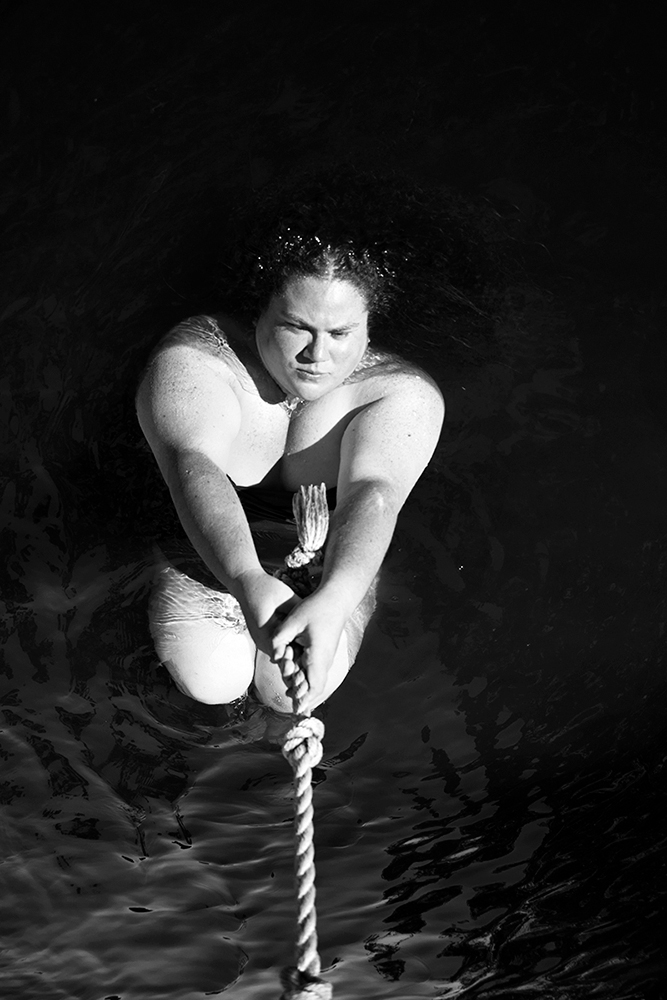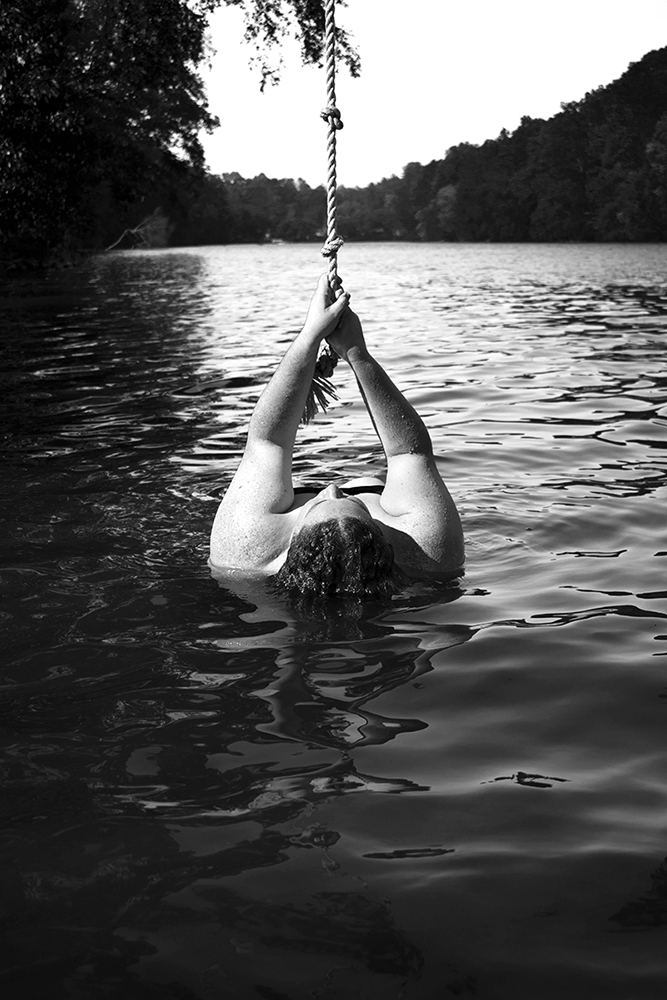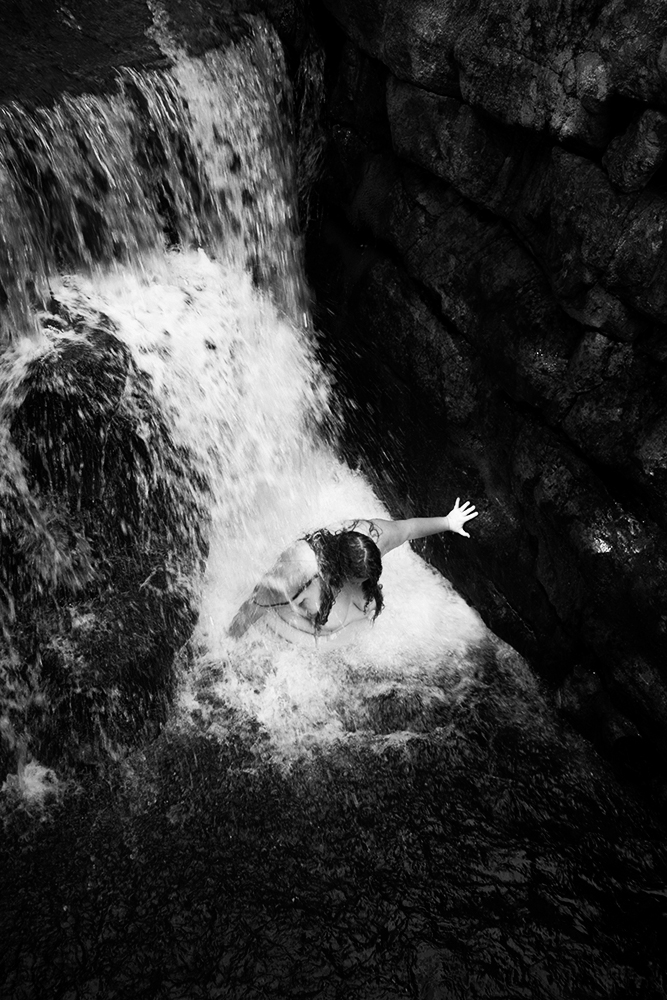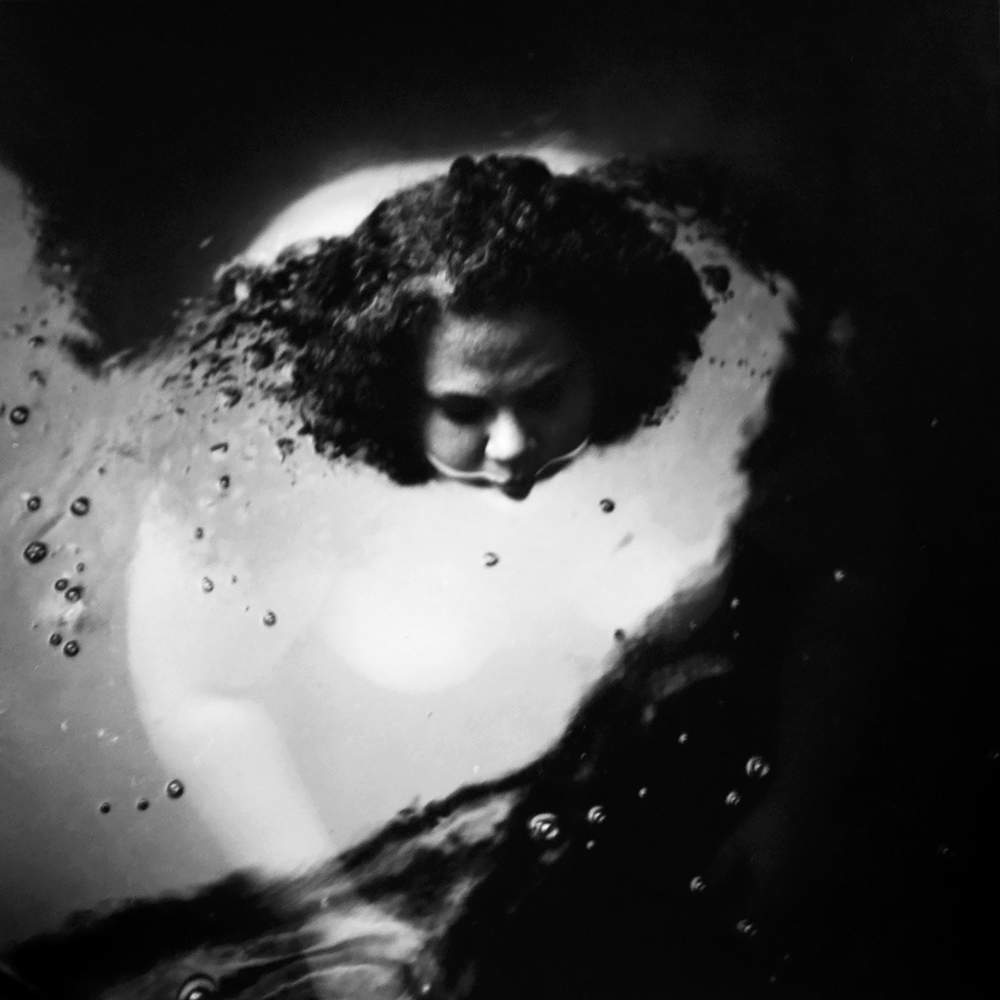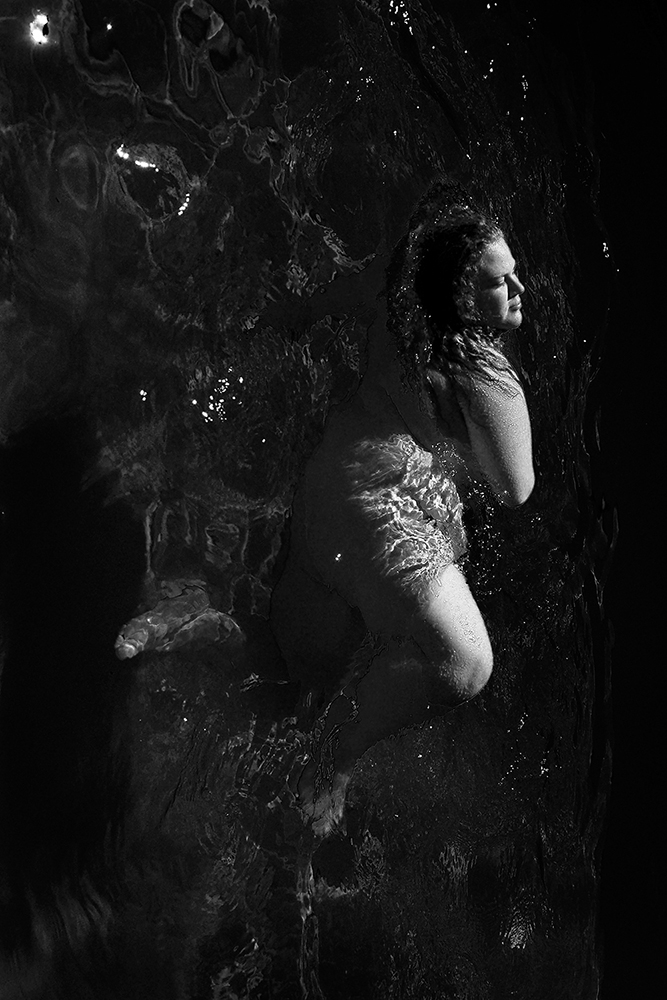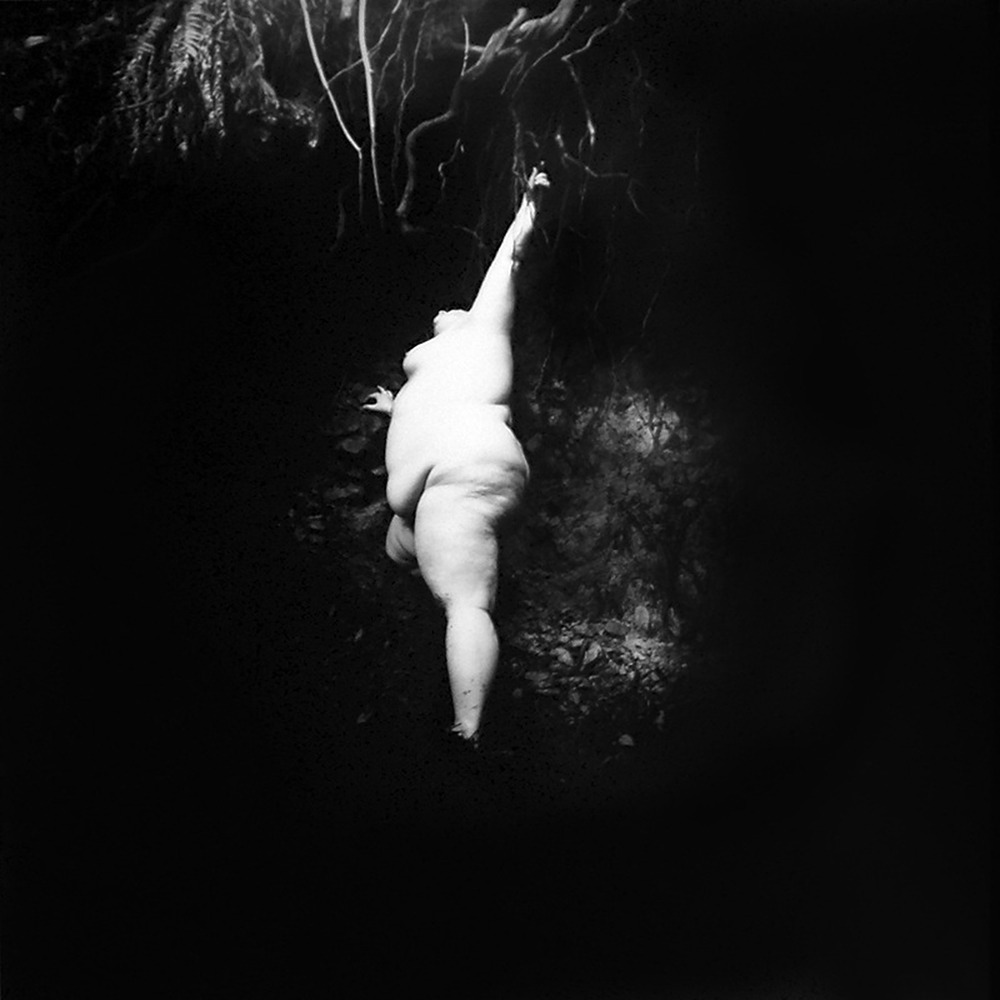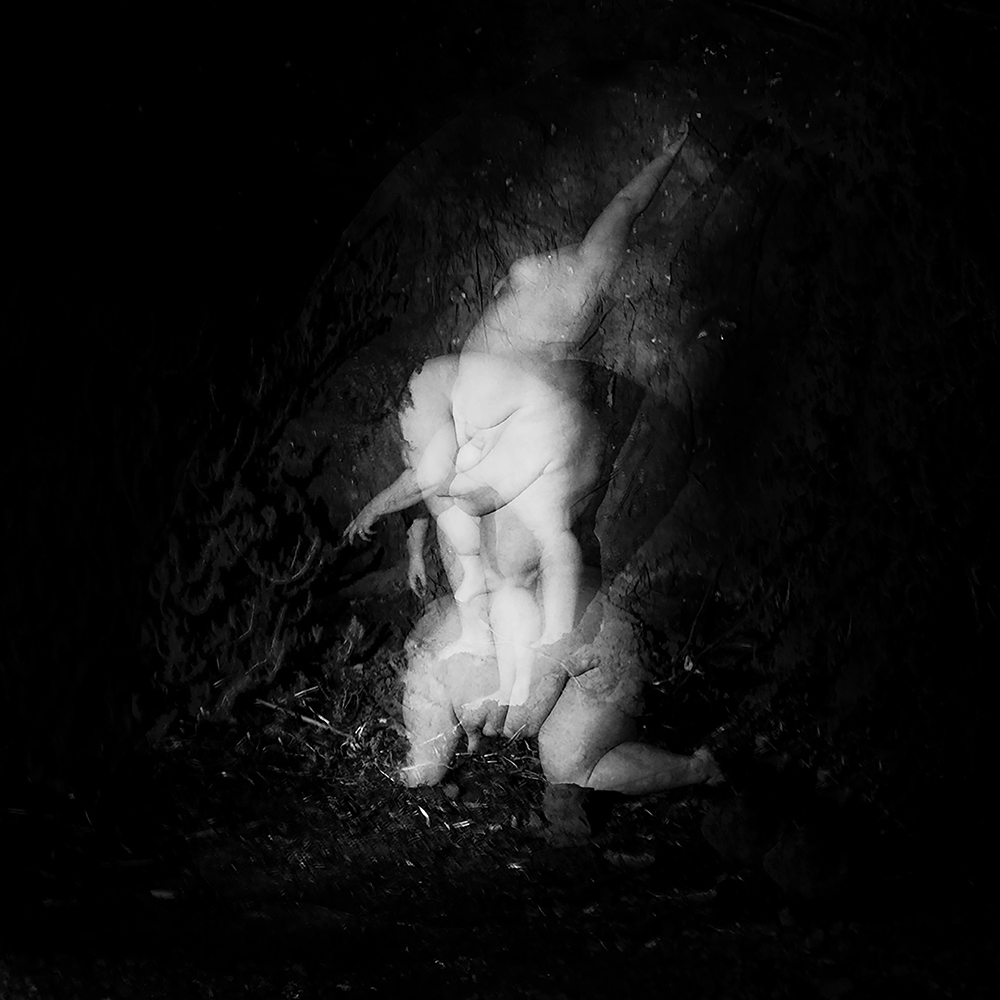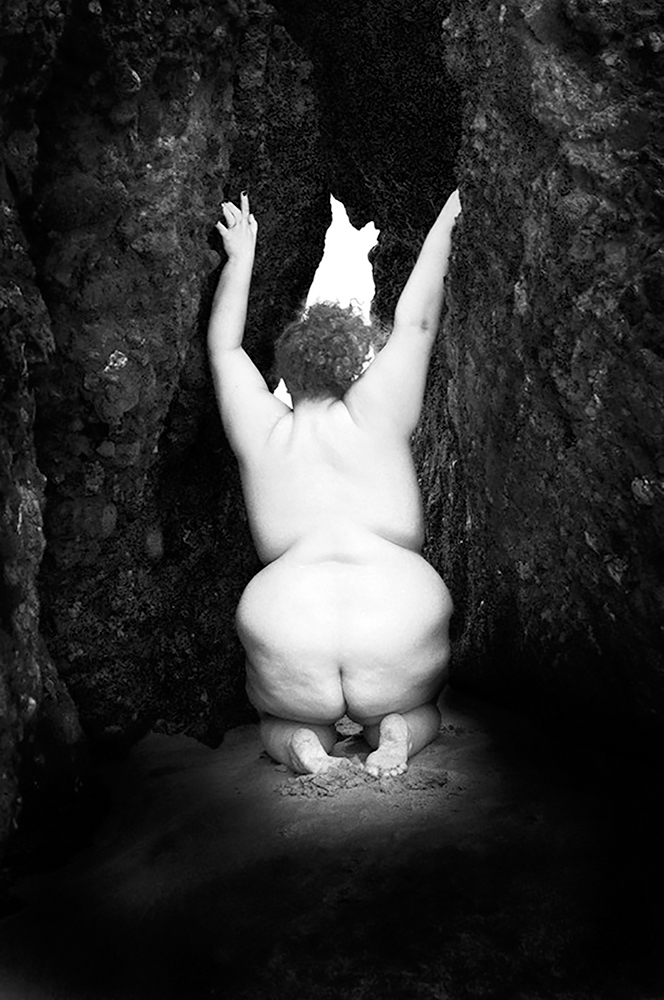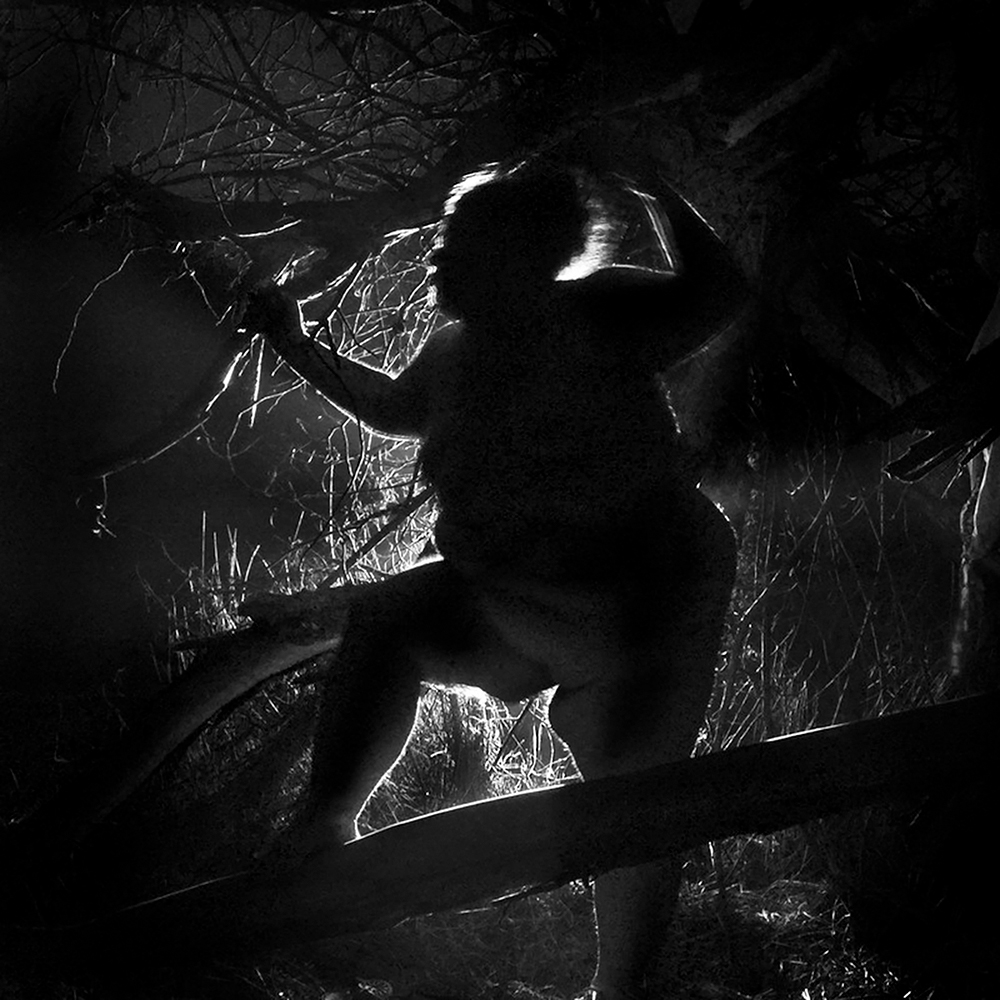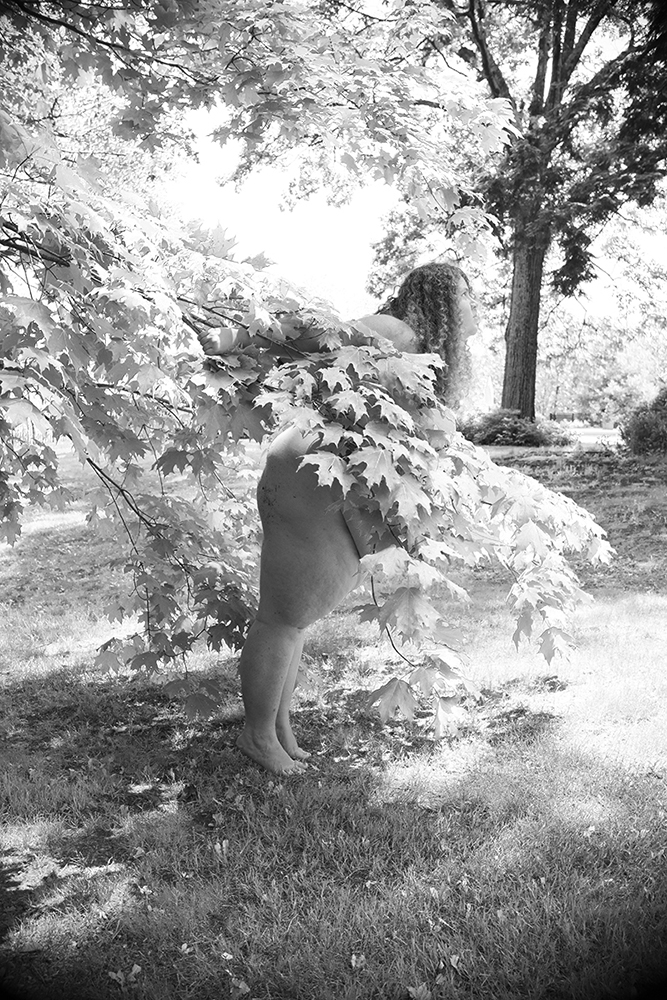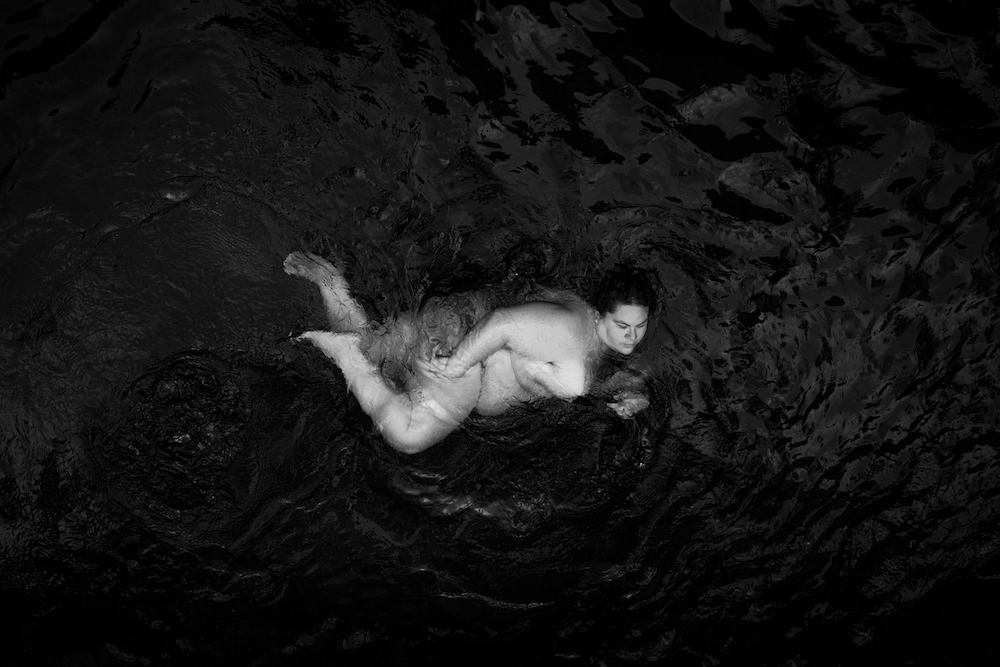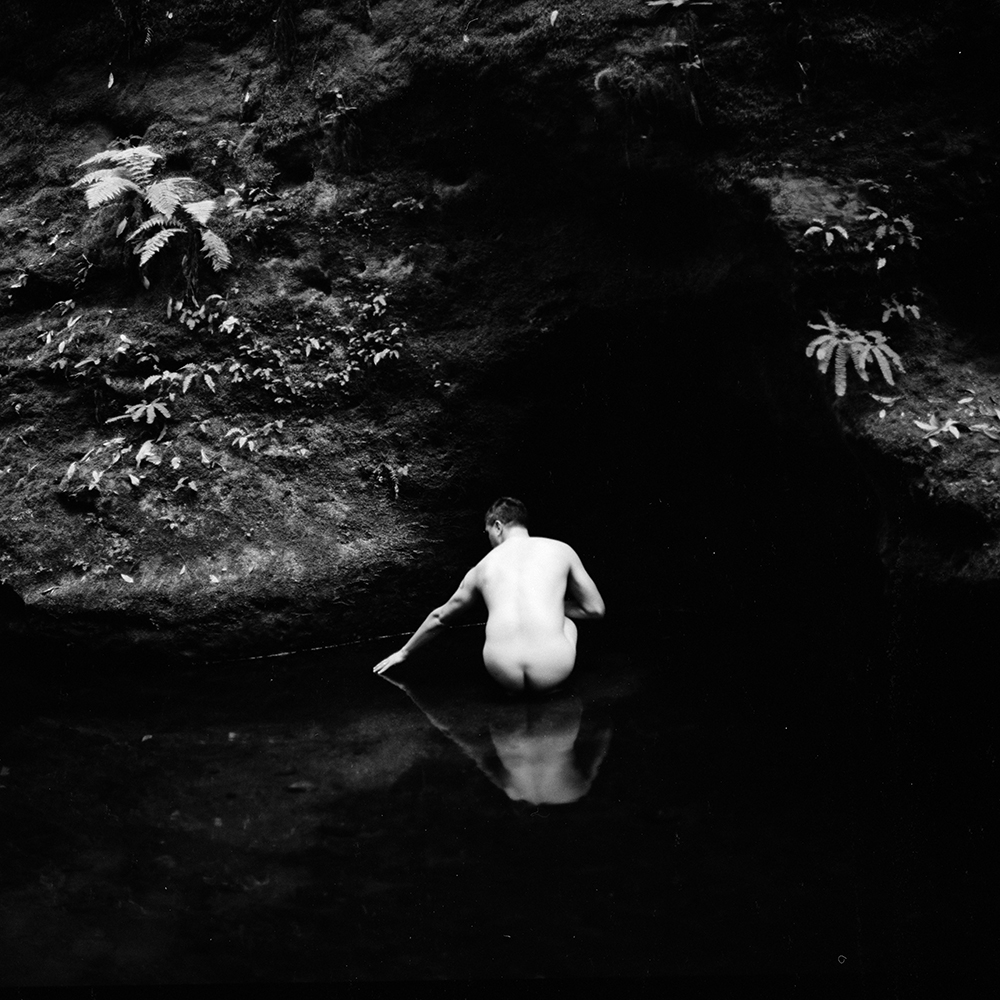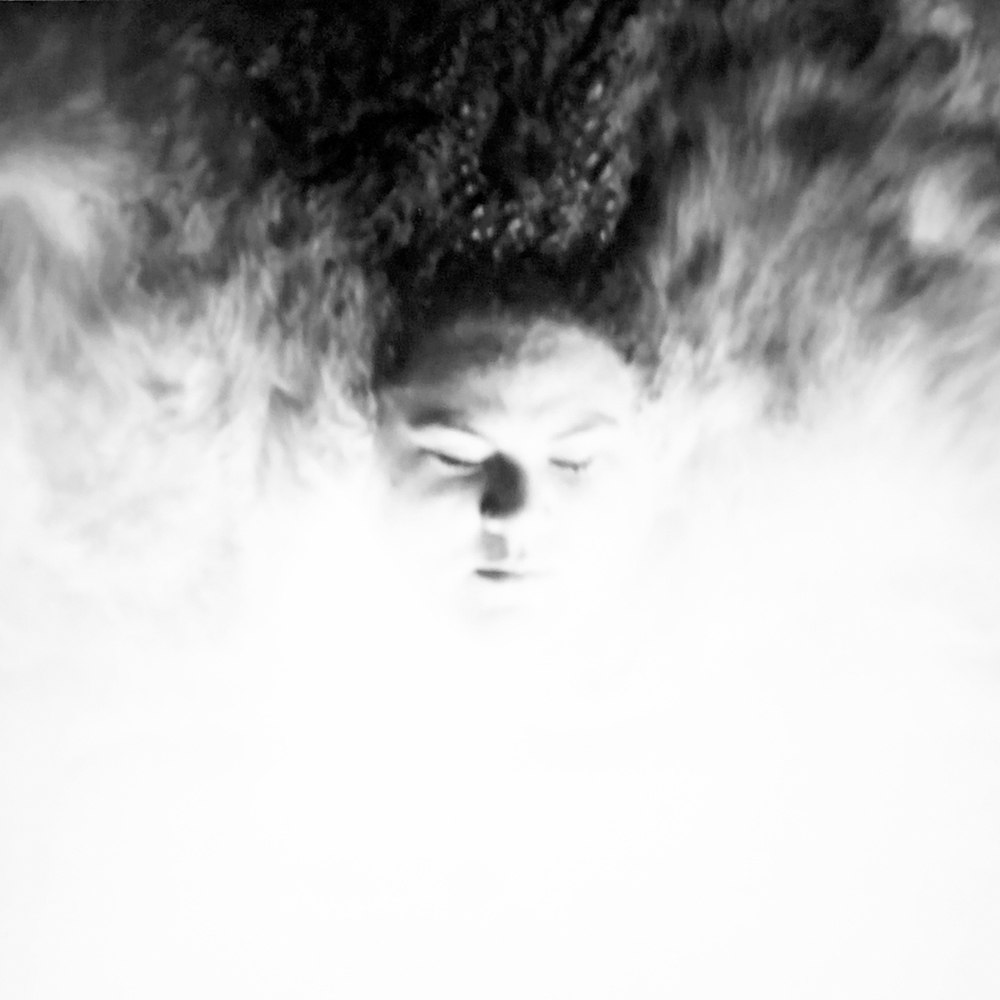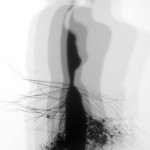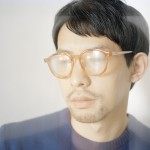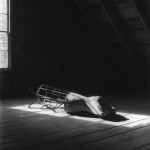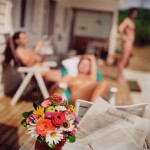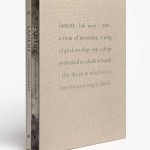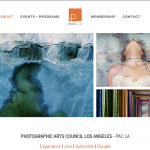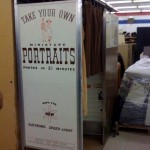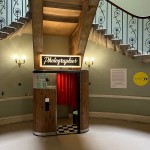Photographers on Photographers: Samantha Geballe on Brittney Cathey-Adams
I met Brittney Cathey-Adams while she was living in the Bay Area in 2015. She instantly felt like a friend to me, and we bonded over too many things that it would begin to sound ridiculous if I explained them all to you.
Over many years, Brittney has continued working on a self-portrait series that brings up discussion around feeling, space, body, boundaries, respect, and compassion for the humanity of another being. She is a strong figure and a person of size whose images show me her body is fine, despite the gravity that pairs with being bigger than what others’ threshold for tolerance is.
We’ve spent time discussing what it’s like to experience difficulty in spaces, whether that be with others and in public. We’ve also talked about how a reach that deep follows you home. Body is an aspect of her photos, but I would say they are an experience of vulnerability. Shooting nudes is a necessary practice of trust. She lets others (including self) see what may be painful or scary. She shows her needs.
It makes sense to me that she would choose to shoot in the forest. It’s a place where there is freedom and space for your own breath. To fit includes being suitable, acceptable, adequate, proper, well, fine, robust, strong, matched, etc. A space that allows for you to be there.
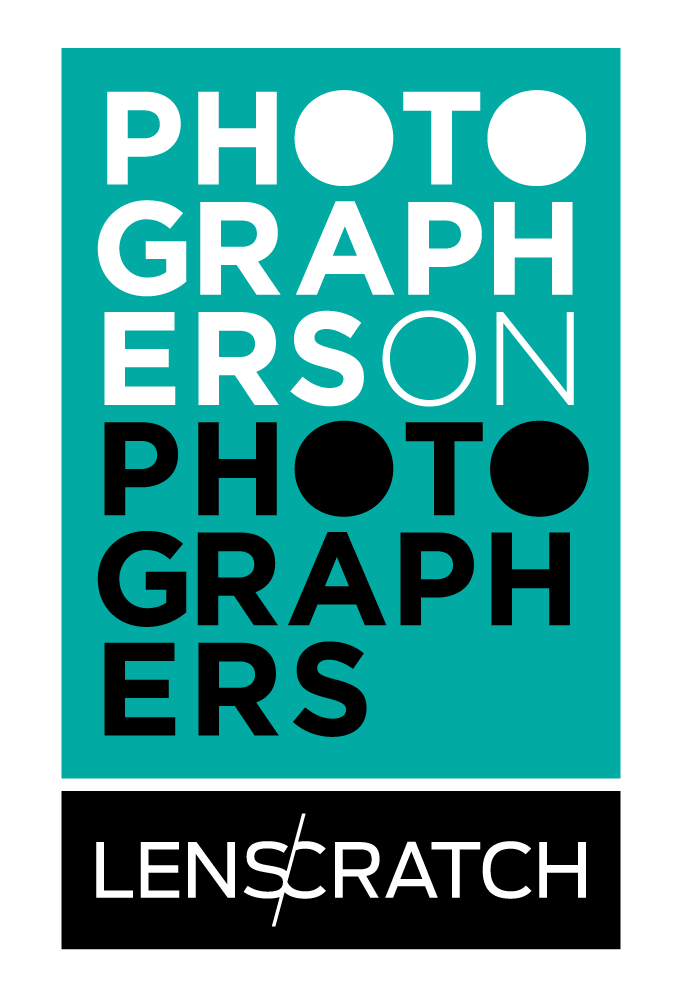 Samantha Geballe is an artist recently re-located from Los Angeles, living and working in the San Francisco Bay Area. Samantha has been involved in art since childhood, and has always used creative expression to connect with others. Her work explores emotion from the inside out. She is working on a self-portrait series that reflects on self-image and healing, and challenges viewers to investigate their own self-acceptance.
Samantha Geballe is an artist recently re-located from Los Angeles, living and working in the San Francisco Bay Area. Samantha has been involved in art since childhood, and has always used creative expression to connect with others. Her work explores emotion from the inside out. She is working on a self-portrait series that reflects on self-image and healing, and challenges viewers to investigate their own self-acceptance.
Brittney Cathey-Adams is a photographer currently living in Portland, OR. Her work deals with body politics, fat activism and the nature of perception. She teaches at Portland Community College, as well as works for The Oregon Jewish Museum and Center for Holocaust Education and as a freelance consultant for LensCulture. She was recently a 2017 Artist in Residence for the Center for Photography at Woodstock.
As a fat bodied person, I am told that I must operate under shame and that it must always be present. I’m told I must shrink myself as much as possible. In 2011 when I stood in front of my lens fully nude for the first time, I had a radical change in self-perception. I realized for two decades I had apologized for my body. As my work began to develop I photographed with one question in mind, “What does this body feel like?” I began to answer by taking up space, and making a body that is seen as a temporary state feel powerful.
This work questions not just who is allowed to be photographed but how. Change is made by expanding representation. Who is permitted to take up space in photography matters. The image has great power in forming our belief systems. The absence of the fat body in photographic imagery communicated its devalued attitudes in our society. Worse is when the fat body stands for the grotesque or as metaphor to weakness and greed. These oversimplifications remind fat bodies that the simple act of taking up more room in this world is unacceptable.
In my images the body is at war and peace, capable of sensuality, quiet moments and small gestures. To look is not the same as to see, and with each image I gain the sight necessary to proclaim the validity of this body. There are moments where I’ve concealed, ones also where I’ve revealed. Over the years I’ve learned that this strength is not due to the absence of fear, but the acknowledgement of its presence. Each time I take a step into discomfort I open up a new place I’ve never allowed myself to live, – Brittney Cathey-Adams
Samantha Geballe: In one sentence, who are you? In one other sentence, tell me what kind of artist you are?
Brittney Cathey-Adams: I am an event in the history of this world that will never happen again. I am an artist who heard those words once and ran boldly into dismantling the walls I built up around myself.
SG: We’ve had a lot of conversations about your race. People often don’t know that you are also of Mexican and Native American decent. How does that feel for it to be dismissed, and largely unknown?
BCA: As I child I was really confused about it, the experiences that formed me told me I didn’t belong anywhere. I was told to choose the ethnicity bubble on tests that I “most looked like” and even back then I knew that didn’t feel right. As an adult I’ve been coming to understand that the name I have been given, the exclusion of my Mexican culture to my upbringing, and the silence surrounding identity is the assimilation that protected my family in a small white conservative community. There was a sense of loss about this earlier in my life but I cannot deny that “passing” means privilege and that knowledge in not understanding first hand oppression means I must put in the work to advocate and assist others.
SG: weird question, do you have feelings about your hair and the commentary around it?
BCA: Absolutely, my hair was one, out of the many reasons I was different to my peer groups. I would have women chase me around stores trying to pet me and so many people reach out to grab it, which happens even still. It was the reason for awful nicknames and I would often find things in it later that others would throw in it as a cruel prank. Through all of the challenges I did learn to embrace and love my hair but it took some hard work and education while all the while understanding that the intersection of identities as well as “dress codes” make it that much harder for black hair to be accepted in our society. The commentary about what “professional attire” looks like has always excluded this community and it’s more than time these definitions were broadened.
SG: You attended an artist residency at Center for Photography for people of color in Woodstock last year? Can you please briefly explain the organization and residency? What was your experience? What did you learn?
BCA: Center for Photography at Woodstock (CPW) is a non-profit photographic organization in Woodstock, New York that has been supporting artists for over 40 years. Through exhibitions, residencies and workshops they connect not only with their local photographic community but work to bring artists from afar to the center for these opportunities. CPW’s artist-in-residence program aims to support dialogue around diversity, race and social justice to artists, scholars and curators who have been underrepresented in general programs. My experience with them as a 2017 AIR was phenomenal. The staff was so engaged and helpful whether that was technical help or in-depth conversations about the work. It was such an invaluable experience I am so grateful to have had, and I learned so much about my process over the month long residency. My biggest takeaway was that my struggles as well as my triumphs build the work I make now, for a while there I got stuck trying to be only positive, or that as someone working for fat activism that I had to deny my weakest thoughts. Understanding that my identity and strength is built from both is what I found in the quiet moments of this time with CPW.
SG: What was it like for you to apply?
BCA: You and I had a big conversation about this once. My mentor sent me the application in an email with the subject line, “Think about this ok???” I remember questioning whether or not I was someone who should apply. Keeping those privileges in check I kept asking myself, am I someone who needs this boost? Do I deserve to have this experience? Looking back on it I can see my inner demons devaluing my experiences and I think even you pointed that out to me at the time.
SG: is that the first time you’ve lived away from everyone you know?
BCA: Yes! I grew up sharing a room with my sister until I moved out with my now husband. I’ve always been surrounded by family and finding a moment alone was rare. At CPW I had the pleasure of writer and educator John Edwin Mason being my housemate at the AIR house. He told me he hadn’t lived with anyone in a long time and I had to laugh as I told him I hadn’t lived alone my entire life. It was a struggle for me, and as much as it gave me the space to think and have alone time I’ve learned that I feel most productive when I connect. CPW was pretty great about me integrating myself into their work week, just to sit and work around people working inspires me.
SG: You are married and have been with your husband, Damien, since age 15?
BCA: Damien and I have been together since we were 14. I was just telling someone recently that looking back at us then, we were such in love sweet idiots. We really put in the work, and we had to if we wanted to make it, we have both changed so much since being teenagers but I’m thankful to have grown together so strongly.
SG: How has your self-image articulated itself by this long-term relationship?
BCA: When I was younger his love for me was what mattered most. I thought, I’m worthy because this person loves me! To be honest we both thought that, and it’s taken that hard work and evolution to understand, I’m worthy because I love me. As much as our lives are together I’m glad that self-worth and self-love is what we each work on, we cannot fill the other person up, nor can we fix each other. We each have to come at this relationship as two whole people.
SG: I know that you also shoot Damien nude, how did that first happen? Is he the only other person you’ve shot nude? Why is it important to you?
BCA: When I was photographing more with my Bronica I would have him stand in my place while I focused the camera. It was rather natural how photographing him came about but when I proposed photographing him nude I felt again that power dynamic of what it’s like to photograph others. When I first started photographing the body my work was primarily others. I used fellow students and friends from my time at Humboldt State University but quickly decided that I couldn’t ask others to do what I was too afraid to do myself. Photographing Damien is important because he and I have so many conversations about masculinity, about the dynamics of our relationship and the generalized ideas of husband and wife. I wanted to photograph him not just in the way I see him but in his ways of rejecting typical masculinity and notions of how men should carry themselves.
SG: I’ve seen you shoot him from afar when we’ve worked together, how do you make him feel safe and supported?
BCA: It’s so surreal to watch someone in the venerable position of the portrait as a predominantly self-portrait artist and so I find myself really going into detail about what my intentions are, pre-visualizing shots and explaining them, then constantly checking in with a lot of questions, just to make sure that at any point during the shoot, he isn’t just putting up with it.
SG: When was your first nude self-portrait and what made you decide to take your clothes off?
BCA: Up until I started Graduate school I had never photographed myself from head to toe nude. You and I have talked about fear a lot, and I remember saying to you, I love finding what scares me. Each time I find a line I’ve drawn in the sand I look at it and think, well it’s time to step over this. My first head to toe nude was probably in 2011 and I just thought again, I am most afraid of my body, really showing it, and all the things I try to hide with clothing.
SG: what do clothes mean to you?
BCA: They conceal the body. I remember thinking when I was six, if I have shirts big enough no one will see that my body is flawed. I used clothing to hide, and to bury myself. I know clothing can be used to adorn the body, to build identity, and to make people feel empowered, but I never had that relationship to it.
SG: Why the forest?
BCA: My formative years were spent amongst the forest. My mother sometimes apologizes that we didn’t get to have a lot of things, but growing up being taught to swim in the river, or taking walks through the woods never left me wanting. I found it only natural that the place I feel the strongest is in these types of environments. It terrifies me a little as much as it brings me comfort, and you know now how I feel about what scares me, I’m going to run right at it.
SG: What’s your self-portrait inner dialogue? How does this differ from your inner dialogue while shooting Damien?
BCA: My inner dialogue is about feeling grounded into this body. When I’m in front of the camera I think, how can I take up space, how can I move my body, how does this look, how do I feel? It’s document as much as it is performative for me, and just the practice of spending time in front of the lens is such a form of self-care and investment in myself. When I photograph Damien I’m thinking, how do I feel about him? How can I show the tenderness of him? How can I photograph him in a way that is soft but strong, just like him?
SG: How do you feel about society’s lack of space? Both inside and outside of your home? Finding ways in which I didn’t fit within my own home was very difficult for me. How do you experience it?
BCA: Lack of space is really hard. I find myself getting irritable, up-tight and plain angry if I’m in a place that cues my body to be a bother. Living in Portland I’m in the land of cute coffee shops complete with chairs I’ll never sit in. I advocate for myself as much as I can but the erasure of my existence through places that don’t accommodate mostly means that I avoid certain places. I have to say though Portland has an active and engaged fat positive community who works really hard to change the game on spaces fat bodies are considered.
SG: I know Artist Laura Aguilar’s images fucked with you, why?
BCA: I’ll never forget that moment, sitting in class at Humboldt State when her work came up on the slide projector. I felt exposed and betrayed. Her work struck such a deep nerve because I felt like she broke the fat girl code I followed my life by. How dare she be vulnerable, how dare she be boldly fat, how dare she be naked. It didn’t take long for me to understand I was talking about myself and not her work. Those images held a mirror up to me and said, look at what you’re hiding from! Her work saved me in so many ways and I’ll be forever grateful. From October 13th-November 3rd at Avenue 50 Studio in Los Angeles I will be paying tribute to her legacy in the show Viva Las Fotos: A Day of the Dead Memorial for Laura Aguilar.
SG: When I shoot self-portraits, I hide things from myself and others (usually because I’m afraid and ashamed,) do you do this too? What do you hide?
BCA: It’s all about the conceal and reveal right? Self-portrait sometimes feels like the sleight of hand magic trick that says, look over here, not over here! In the beginning of my work I hid the body, I hid the face, I hid exactly what part I was photographing. Now I at times hide the fear, hide the discomfort, or attempt to negotiate myself out of my weaknesses. I’m ashamed that I sometimes feel ashamed, isn’t that the kicker. I’ve done so much work to advocate for my body, for bodies like mine and for a more positive light, but if I think that photographing the body for ten years can outweigh my three decades of learned behavior I’ve got another thing coming. This will take time, and work, and self-honesty, I’ve only scratched the surface.
SG: Personally, I’ve adapted to turning my mind off to the fact that it’s me during an edit to avoid getting hung up on negative self-talk.
What is your editing experience like? What do you feel?
BCA: I understand what you mean, there has to be some distance with subject, we’re too close! In editing and in critique I have to separate myself a bit otherwise that negative self-talk gets to me too. I tell myself to treat me like I’d treat others in editing. There are very few things I have photoshopped out of my work because of this too. I’m by no means a purist, but if an element of the portrait detracts from the intention I will lightly remove what is necessary. I can get too hung up on how my face looks and so I’ve got to check those feelings at the door when editing.
SG: We’ve been collaborating for some time now, with modeling in each other’s series’. I often feel nervous, like I’m going to fuck up, and that I’ll do a bad job – what’s your experience like shooting together? What do you want to say in working together? Where should we go?
BCA: I feel nervous too! I remember I said to you, I don’t want to be the “before” body in your work and I don’t want you to feel like the “goals” body in mine. It’s such a delicate balance and well, we both like our control in our own work too, which makes so much sense for two people who know what it’s like to feel powerless sometimes. For all those self-conscious thoughts I have photographing with you though there is also tenfold a sense of connection, comradery, friendship and strength. It’s terrifying to see the way someone else sees you, but when I saw one of the images you made of me, I felt so understood, so seen, and so strong in your eyes. I want to validate both of our experiences, we’ve both felt that cruel sting of not fitting into communities based on either being fat or with your choice in surgery. Our experiences are not to be discarded, and from here I want to shoot even more, where is that fear and can we chase it together?
SG: Do you have a different experience processing someone else’s photos of you?
BCA: Just as I said above about the one photo I remember most vividly, it was so powerful, and it felt not just like you see me, but how I want me to see me if that makes sense. I’m always working that way in my own work too, it’s like re-writing a personal narrative, one where I don’t have to feel ashamed of myself. I remember when you took the portrait I’m thinking of too, you said to me, “You are beautiful,” and I said, “I’m really understanding that feeling more and more. It was a moment I’ll never forget as you pressed the shutter.
SG: You are a teacher, and have been teaching for some time now, and know that you love it. I don’t think there is much more of a noble profession than teaching. What do you love about it? What do you love about your students? What do you learn?
BCA: I love when my students find their voice, the one that they are so uniquely qualified to speak from. A student I had recently found photography to be a way to speak of things he couldn’t formulate into words, that is so important. Photography is communication, I tell each class that what you want to say is the question left long after you’ve learned what aperture, ISO, and shutter speed are. It really all comes full circle for me, the act of giving back after what has been given to me. The students teach me so much about compassion and understanding. Each class I learn even more about why representation matters and how seeing themselves in the artist I show is a pivotal part of belonging and permission. They challenge each other, they build ethics and they experiment, it’s the best feeling to watch them get excited about the tools of photography but even more when they find the dedication to their practice and themselves.
SG: Were you ever camera shy? Are you still? If only with certain people?
BCA: Absolutely, you have to understand for a second, I grew up fat, cross-eyed and with a curly red mullet, the camera was a reminder of all the ways I didn’t look “right.” It’s probably why the camera entranced me, you can’t be in photos if you’re the one taking them right? I got my own camera at age 8 and there is where my relationship with power began. I would say I can still be a little camera shy, only because I like to be in control of my image, but also I’m trying to make peace with this idea that there is no wrong way for my body to look.
SG: Has shooting self-portraits influenced how you pose in iPhone photos?
BCA: I love this question! I have never considered the way it has changed the more casual photos of my life but it has! Just last week I posted a photo of myself in a swimsuit. The changes my work has made in me push me to be more open and more challenging of my own inner dialogue. I don’t think pre 2011 me would have ever posted a photo of myself in a swimsuit, but there were a lot of self-imposed rules I used to follow before starting my work. Photographing self-portraits has also made me an intense selfie advocate. Art history books are filled to the brim with rich white men who commissioned paintings of themselves, so you selfie all you want.
SG: When you come across a photo that feels too vulnerable, do you edit your next shoot poses in a way so that you don’t see it again?
A.) is it ever painful?
B.) is there joy?
BCA: This is one of the biggest questions for myself. How do I choose my work? Out of all the shots I’ve taken, do I choose some work over others because I’m self-conscious or is it that the image isn’t as strong? Do I edit out images subconsciously that make me feel painful? I’m still trying to figure out the answer to this question, it almost makes me want to create a portfolio of work I thought was “bad” just to challenge this idea. Amongst all the talk of fear and vulnerability there is joy. I have had powerful moment within my work, I’ve thought, “Yes! This is what this feels like!” I’ve fought in a lot of ways for my voice, and so getting to take a step back and feel pride and joy is important. I’ve come a long way from being the kid who didn’t talk until the second grade.
SG; How do you use your voice in imagery? (write it in a limerick.)
BCA: There once was a sad girl who used to meow
She wanted to talk but didn’t know how
Grabbed a camera she did
And no longer she hid
Standing before the world brave here and now
SG: What work do you want to see from others?
BCA: If I haven’t said it enough, vulnerable work. I get it, sometimes the romanticizing of the emotional in the art world can make people roll their eyes but I really feel like whether you are documentary, fine art, or commercial, understanding yourself will always benefit the way you shoot and what you shoot. So maybe, it’s not a particular subject, but it’s more about taking your choices into consideration and that those are formed by your life and experiences. The question I love more than what kind of camera do you have, or what type of paper is this is why do you photograph the way you do? That type of understanding is undervalued.
SG: What conversation is too quiet?
BCA: The conversation about work of the underrepresented being made by the underrepresented. I have seen so many subjects treated with this voyeuristic approach and while I don’t want to dismiss the act of looking I think the voices of experience should be priority. Not work about black, fat, queer, trans, disabled as witness but as experience. That space for these voices is something I want to see more of from the fine art world and that will mean stepping aside and doing a lot more listening than talking.
SG: Will you please write a haiku about your life with you?
BCA:
Breathing in deeply
The camera collects each frame
I forgive myself
SG: Lastly, please write a knock-knock joke about your camera.
BCA:
Knock-Knock
Whose there?
Film
Film Who?
I’m not dead yet!
Posts on Lenscratch may not be reproduced without the permission of the Lenscratch staff and the photographer.
Recommended
-
Linda Foard Roberts: LamentNovember 25th, 2025
-
Arnold Newman Prize: C. Rose Smith: Scenes of Self: Redressing PatriarchyNovember 24th, 2025
-
Spotlight on the Photographic Arts Council Los AngelesNovember 23rd, 2025
-
The Aline Smithson Next Generation Award: Emilene OrozcoNovember 21st, 2025
-
MATERNAL LEGACIES: OUR MOTHERS OURSELVES EXHIBITIONNovember 20th, 2025

